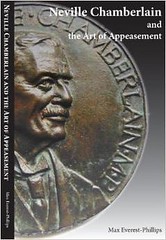
PREV ARTICLE
NEXT ARTICLE
FULL ISSUE
PREV FULL ISSUE
BOOK REVIEW: NEVILLE CHAMBERLAIN - THE ART OF APPEASEMENTLast week, Paul Bosco told us about a book with information on medals relating to British Prime Minister Neville Chamberlain. Ron
Haller-Williams located the Amazon listing for it, and when I went to the page I was delighted to find that Chris Eimer had provided a very nice
review of it from a numismatic perspective. Here it is! Thanks, everyone. -Editor
Dismounting the steps of his return flight from Munich on 30 September 1938, amidst the assembled crowd of press and newsreel reporters at Heston Aerodrome, Neville Chamberlain, British Prime Minister, waving a piece of paper jointly signed by Hitler and himself that morning, announced that he had obtained `Peace in Our Time'. This brief but widely-known episode constitutes the culmination of the Munich Conference, the two-day meeting on 28-29 September between Hitler, Mussolini, Edouard Daladier (President of France) and Chamberlain - and the backdrop to this fascinating book - during which the terms of peace were agreed, the fate of democratic Czechoslovakia having been left to the mercy of the Third Reich. The collective sigh of relief at Chamberlain's apparent success gave rise to the issue of commemorative material, much of it in the form of medals. Public reaction to the peace was understandable, when seen against the shadow of the First World War; and with its scale of human tragedy still hanging heavy, another such war was to be avoided at almost any cost. Affecting not only Britain but also much of Europe, it is no surprise that medals commemorating Chamberlain and the Munich Agreement also should have been produced by French and German medallists for their respective markets. As well as illustrating the medals, the book includes a great deal of relative material in the form of cartoons, and with a cast of characters that include Hitler, Mussolini and Chamberlain, what better source material could a caricaturist possibly wish for. Also included are photographs of the main protagonists, their manner of interaction providing an additional angle of interest, as we see observe Chamberlain blithely walking into disaster. We learn how the British Prime Minister was to stage-manage the media for purposes of public consumption, allowing himself to be photographed with Mrs Chamberlain taking a stroll around St. James, as might any ordinary couple, or fumbling with the keys of Number 10 Downing Street, as they are seen at its back entrance unlocking the door. The book captures the heightened emotions of the period, extracting a speech delivered to the House of Commons by Clement Atlee, four days after Chamberlain's return from Munich and the `sense of relief', following `days of anxiety' , and what some considered neither a victory for reason and humility but one for `brute force'. Amongst the more amusing images is that of a troupe of six leggy female cabaret dancers, each moustachioed, wearing a top hat and carrying a furled umbrella on their right arm - Chamberlain being very much the man of the moment, day and night. The book provides an extensive catalogue of the commemorative medals issued in 1938, and beyond, and includes many of those made under Nazi Germany, detailing not only the medallist but also, where known, the publisher and issue price. In dealing with those made by the prominent German satirist Karl Goetz, the author raises the question of this medallist's sympathies, so clearly defined and projected are his medallic designs of this time. The book illustrates just how powerful the propaganda value of the medal happens to be, and the episode that it covers is as good an exemplar of this as it is possible to find. It was the chance discovery in 1994 of Muriel Hiley's uniface portrait medal of Neville Chamberlain, spotted in the window of a south-west London junk shop, which set Max Everest-Phillips on his quest. Scattered far and wide as this material has become, the author has dug far and wide to produce a work of considerable interest that both entertains and informs, inviting us to look afresh at this extraordinary period of recent history. Christopher Eimer
Ron also noticed some typos in that earlier post, most notably a misspelling of Chamberlain's last name. Sorry I missed that -
we'll fix our archive. -Editor
To read the complete review, see:
To read the earlier E-Sylum article, see:
Wayne Homren, Editor The Numismatic Bibliomania Society is a non-profit organization promoting numismatic literature. See our web site at coinbooks.org. To submit items for publication in The E-Sylum, write to the Editor at this address: whomren@gmail.com To subscribe go to: https://my.binhost.com/lists/listinfo/esylum All Rights Reserved. NBS Home Page Contact the NBS webmaster 
|
